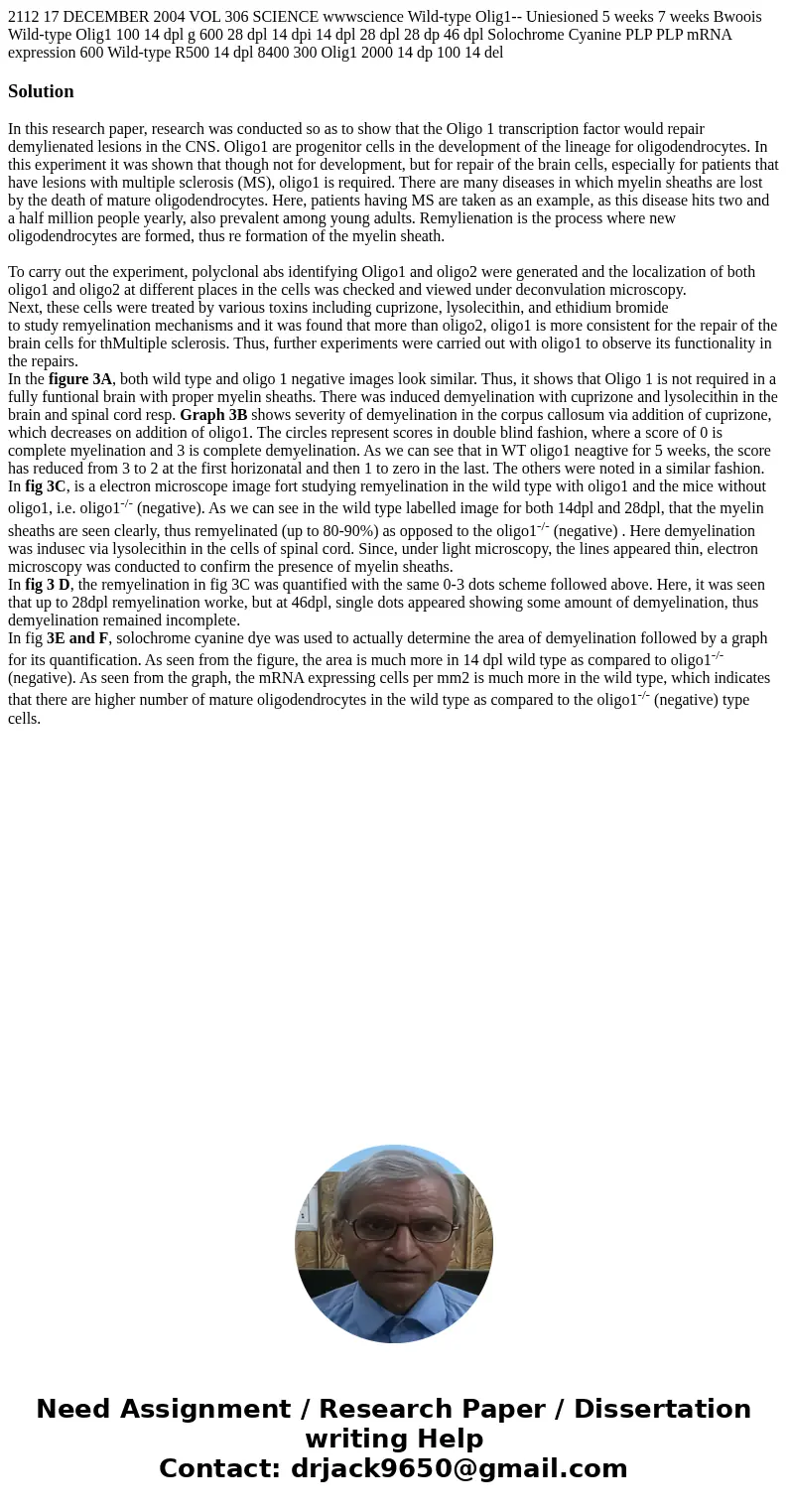2112 17 DECEMBER 2004 VOL 306 SCIENCE wwwscience Wildtype Ol
Solution
In this research paper, research was conducted so as to show that the Oligo 1 transcription factor would repair demylienated lesions in the CNS. Oligo1 are progenitor cells in the development of the lineage for oligodendrocytes. In this experiment it was shown that though not for development, but for repair of the brain cells, especially for patients that have lesions with multiple sclerosis (MS), oligo1 is required. There are many diseases in which myelin sheaths are lost by the death of mature oligodendrocytes. Here, patients having MS are taken as an example, as this disease hits two and a half million people yearly, also prevalent among young adults. Remylienation is the process where new oligodendrocytes are formed, thus re formation of the myelin sheath.
To carry out the experiment, polyclonal abs identifying Oligo1 and oligo2 were generated and the localization of both oligo1 and oligo2 at different places in the cells was checked and viewed under deconvulation microscopy.
Next, these cells were treated by various toxins including cuprizone, lysolecithin, and ethidium bromide
to study remyelination mechanisms and it was found that more than oligo2, oligo1 is more consistent for the repair of the brain cells for thMultiple sclerosis. Thus, further experiments were carried out with oligo1 to observe its functionality in the repairs.
In the figure 3A, both wild type and oligo 1 negative images look similar. Thus, it shows that Oligo 1 is not required in a fully funtional brain with proper myelin sheaths. There was induced demyelination with cuprizone and lysolecithin in the brain and spinal cord resp. Graph 3B shows severity of demyelination in the corpus callosum via addition of cuprizone, which decreases on addition of oligo1. The circles represent scores in double blind fashion, where a score of 0 is complete myelination and 3 is complete demyelination. As we can see that in WT oligo1 neagtive for 5 weeks, the score has reduced from 3 to 2 at the first horizonatal and then 1 to zero in the last. The others were noted in a similar fashion.
In fig 3C, is a electron microscope image fort studying remyelination in the wild type with oligo1 and the mice without oligo1, i.e. oligo1-/- (negative). As we can see in the wild type labelled image for both 14dpl and 28dpl, that the myelin sheaths are seen clearly, thus remyelinated (up to 80-90%) as opposed to the oligo1-/- (negative) . Here demyelination was indusec via lysolecithin in the cells of spinal cord. Since, under light microscopy, the lines appeared thin, electron microscopy was conducted to confirm the presence of myelin sheaths.
In fig 3 D, the remyelination in fig 3C was quantified with the same 0-3 dots scheme followed above. Here, it was seen that up to 28dpl remyelination worke, but at 46dpl, single dots appeared showing some amount of demyelination, thus demyelination remained incomplete.
In fig 3E and F, solochrome cyanine dye was used to actually determine the area of demyelination followed by a graph for its quantification. As seen from the figure, the area is much more in 14 dpl wild type as compared to oligo1-/- (negative). As seen from the graph, the mRNA expressing cells per mm2 is much more in the wild type, which indicates that there are higher number of mature oligodendrocytes in the wild type as compared to the oligo1-/- (negative) type cells.

 Homework Sourse
Homework Sourse